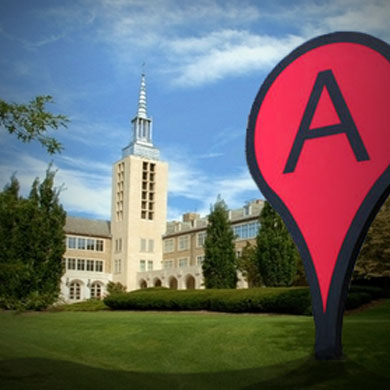Jody Benedict’s presentation on Google Map Maker at HEWEB11 received a best-in-track award.
When Google opened the U.S. for editing in Map Maker in April 2011, campuses suddenly had the opportunity to add detail and correct errors. At my campus, we had a single campus address represented by a brownish blob. Users could easily get driving directions to the main entrance of campus, but they were on their own to wander once they arrived.
If you take the time to add a sufficient level of detail to your campus using Map Maker, your visitors and campus community will likely be able to find their way around even if they didn’t to go to your website first.
Editing the Map
Map Maker lets you edit Google Maps directly, fix errors, add missing points of interest and add detail to existing content. Your changes can be visible to all Google Maps users in a relatively short period of time. You can add your buildings and other points of interest, roads and walking paths, athletic fields, and even correct your campus’s boundary if it’s not quite right. The added detail will make your map more useful to campus visitors and campus community alike.
Here’s how it works:
- You make an edit at google.com/mapmaker and submit it.
- Your edit will then be “pending review” and remain unpublished until an official Google reviewer takes a look and approves it. Usually your edit will go live on Google Maps within 10 minutes of being approved.
- If the reviewer has questions or suggestions, he or she will usually request more information.
- If their suggestions are reasonable, you make the changes and resubmit. If the suggestions don’t make sense, you generally end up having a debate in the comments and eventually resolve it by including additional documentation and references that make your case.
It doesn’t take a lot of technical skill to use Map Maker, but adding all this information takes time. If you don’t have time, this could be a great project for a student worker.
How Much Detail?
You don’t have to add every fountain and statue to your map to make it more useful but some details will add a lot of value for your users. Here are some of the details I have found useful:
- Speed limits, sidewalk information, turn restrictions and traffic signs, as well as information about restrictions on traffic or pedestrian use allow you to tune your walking, biking and driving directions around campus.
- Parking lot information gives visitors valuable information and saves them time looking for parking.
- Building heights give your campus map a three-dimensional look. It may be unnecessary but it makes for a nicer-looking map.
Monitoring your Campus Map
If you do nothing else with your campus map in Map Maker I suggest you at least [Subscribe to neighborhoods][http://support.google.com/mapmaker/bin/answer.py?hl=en&answer=1108788&topic=1094996&ctx=topic] to be alerted to changes on your campus. It’s simple to set up Map Maker to send you an email any time someone makes an edit on your campus, making it easy to either support the mapper’s work or request that they submit more accurate information.
Reviewing Edits
It’s worth reading the guidelines for reviewing edits. The official Google reviewers will be more likely to take your reviews into account when they’re making decisions if it’s clear that you know the rules and you stay positive with the mappers.
Working with Reviewers
Getting your map edits published can sometimes feel like debate club, especially if your satellite imagery is out of date. Try to remember the reviewers are trying to protect the map data. Anyone with a Google account can submit map edits, so careful review is important. The more edits or reviews you do the more reviewers will trust you.
Always fill out the comments section. Provide as much supporting information as you can, including photos and links to campus documents. Let the reviewer know you work on campus and t hatyou really are the expert for your area. Keep this information in a text file so you can copy and paste it in on repetitive edits.
Be patient. It can be frustrating to have someone who has never set foot on your campus suggesting you might be wrong about something you walk past every day. If they ask for more information or deny your request, don’t be shy about explaining yourself further. But be willing to take advice and modify your edit to meet their requirements as long as it doesn’t compromise the accuracy of the information. If you know they’re wrong and you’re having trouble reasoning with them, it can be worth asking for advice in the Map Maker forum or in the Unofficial Map Maker Facebook Group. This is also a good direction to go if your edit remains unpublished for an extended period of time (weeks or months.)
Don’t guess. If you don’t know, find out. If you can’t find out, leave a field blank. One wrong or questionable field could keep your edit from getting published for a long time. It always seems to take longer if the reviewer isn’t sure how to handle something.
When Your Satellite Imagery is Outdated
It’s easy to trace the existing satellite imagery to add buildings and it’s fairly easy to get those edits reviewed and approved. When your campus has added four buildings, removed a road, and added two others but those things aren’t represented on the satellite imagery, it can be a lot more challenging. This is when patience and evidence is really required in working with reviewers.
To add things that aren’t represented on the map you will need to activate image and KML overlays in Map Maker. Then you can either buy a newer satellite image and use that for reference or travel around campus following the roads with your smart phone and an app that uses the GPS to trace your path. Getting an image aligned properly in Map Maker is a challenge.
Is it worth it?
Map maker isn’t perfect but it is widely used. The categories will drive you insane. Sometimes the lack of control can be extremely frustrating. It’s worth at least knowing what people are seeing when they search for you in maps. It will make finding your campus easier for visitors. It will make it easier for for visitors and students to find the bookstore, and the dining hall and their first class. Every place you add will also become a Google Place and places show up prominently in Google’s search results. And despite the frustrating factors, it’s kind of fun.
Resources
Getting Started with Map Maker
Map Maker Pedia
Mapmaker Forum
Request an Imagery Update



3 replies on “Mapping Campus with Google Map Maker”
Google is having a Map Your Campus contest this month. If you’re looking for a way to get students to do the work for you it might be worth promoting. Just make sure you subscribe to your area and review edits.
https://sites.google.com/site/mapyourworldcommunity/competition/2012-us-ca-universities
[…] Mapping Campus with Google Map Maker | Link: The Journal of Higher Education Web Professionals. Share this:EmailPrintFacebook This entry was posted in Web Clips and tagged Link by Christopher […]
Thanks this was very helpful.